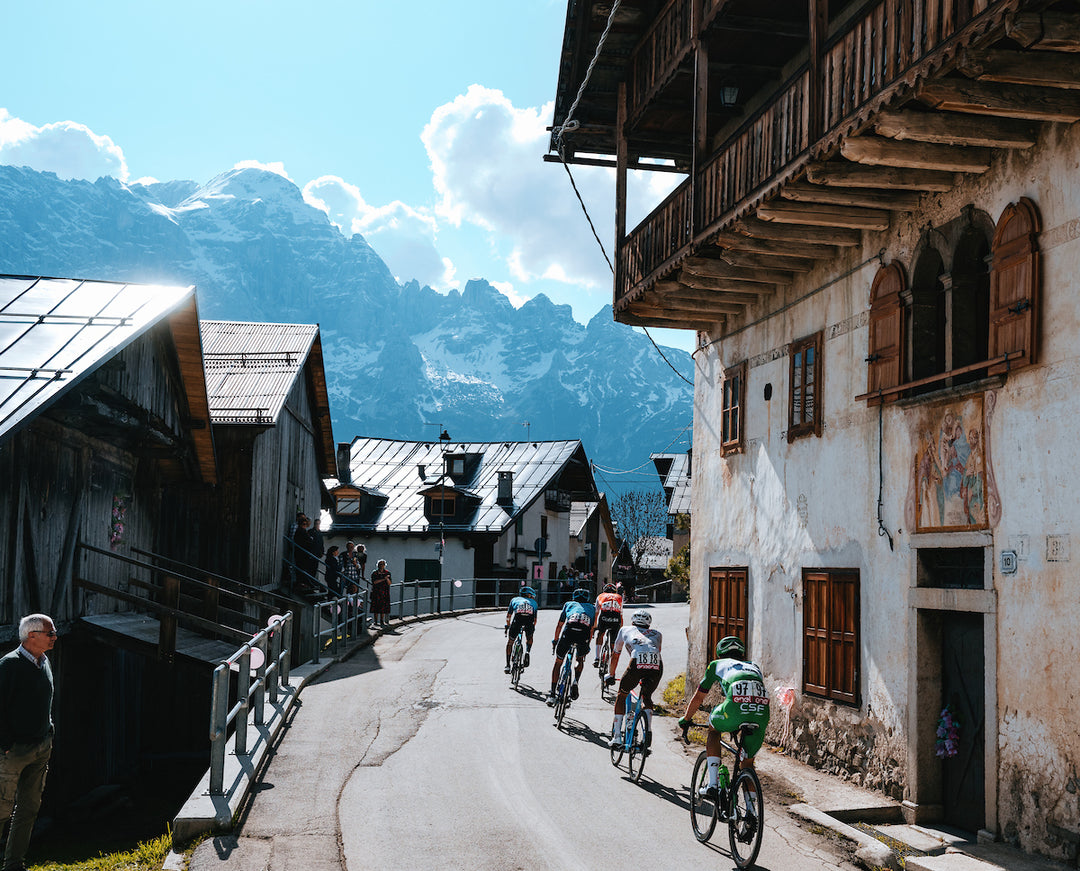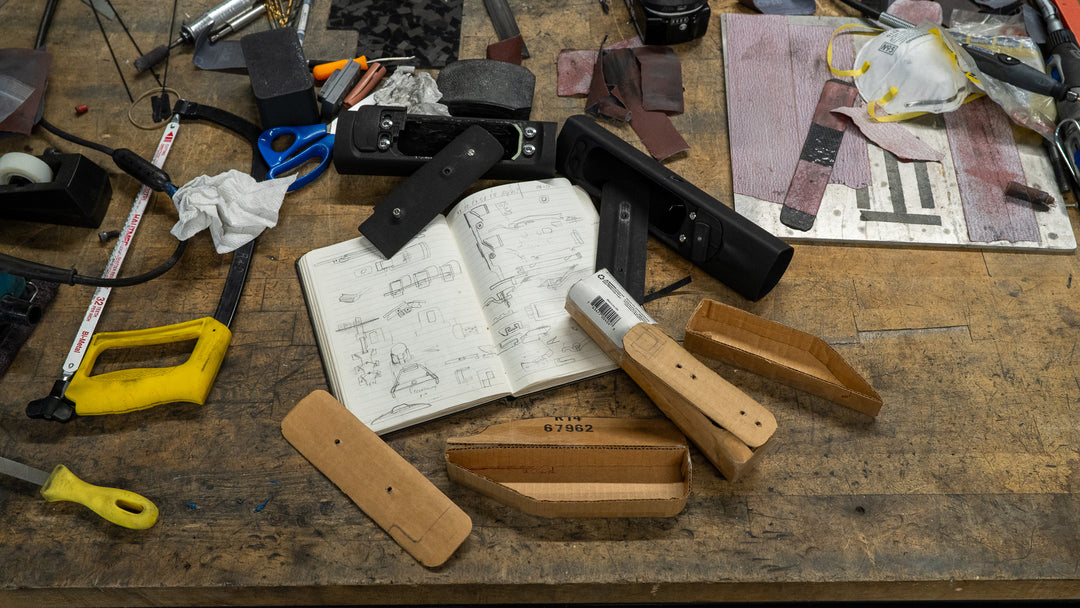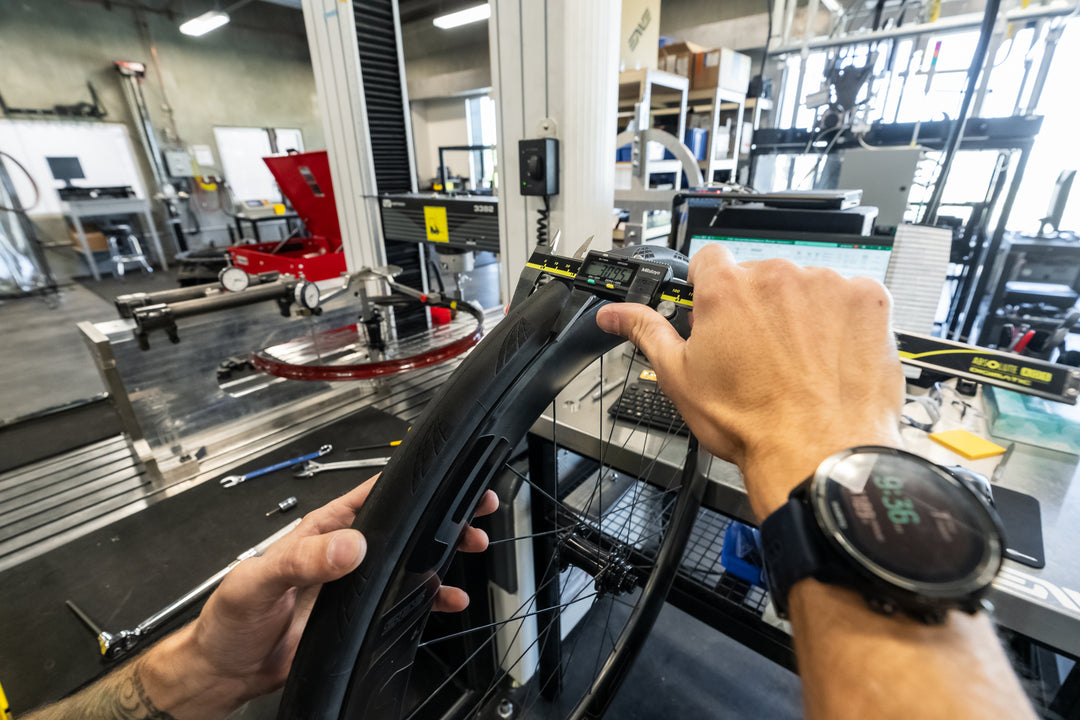Gravel Questions and Answers
Have a question about gravel? A few months back, ENVE participated in Bikerumor’s AASQ (Ask a Stupid Question) series and we think many of you might be interested in reading the responses to questions about gravel you’ve likely had yourselves.
Overwhelmingly, the questions were related to aerodynamics, hookless, wheel/tire fitment, and ENVE R&D.
It seems to be an industry wide agreement that gravel specific wheels (rims) should be quite shallow. As the American gravel scene seems to be the main motor in gravel R&D, with popular events like DK and others. Why have the industry and ENVE in particular, decided that the aero benefit of a taller rim + a well fitting tire, is less important on gravel, even when the ride is 200km + long?
Sure, and a great question. ENVE has been looking at this for many years at this point and we asked ourselves the question of “aerodynamics in gravel” back in 2014 in the development leading up to the launch of the SES AR Series of wheels. What we learned is that basically once the tire exceeds 32mm and gains any side knobs/tread, you lose the majority of aerodynamic benefits. To make an aero rim for a larger tire is possible but it starts to get crazy wide and therefore exceedingly heavy, and again, this is assuming there is little to no tread on your tire. In short, the value proposition just isn’t there. On top of that, there is the fact that gravel riding is often on rough roads, if you’ve ridden or talked to anyone who’s raced DK, you know that the race is rough and also pretty slow. On a long, rough course like DK, a shallow rim with a refined laminate like the ENVE G23 provides compliance and therefore comfort which is invaluable. Also, most gravel rides and races include a lot of climbing. DK is over 11K feet. Again, lightweight trumps aerodynamics at the speeds most are climbing gravel roads at.

ENVE rims have been getting wider and wider while tire size/volume have been increasing at the same time. Despite better tire integration, the first one has been proven to ultimately be less aerodynamic (larger frontal area) than less extreme rims and the second one showed that except being able to use lower minimum pressures and a bit better grip, they were not bringing more absolute performance. Why is ENVE pushing those 30+mm rim widths from an engineering point of view?
Hopefully we understand your question well enough, but it sounds like what you’re asking is “Why if 30mm isn’t more aero, and if large volume tires aren’t higher performance, then why do it? For ENVE, we engineer our SES lineup of wheels for holistic performance. Yes, an SES AR wheelset with a 28-30mm tire is going to have more frontal drag than a standard SES wheelset with a 24-26mm tire. What we achieve with the AR series is first, greater aero stability. A 4.5AR with a 28mm tire is extremely stable in crosswinds and at yaw. Also, there is rolling resistance. The rougher and more imperfect the surface, the more a high volume tire plays into your favor. On a rough road, the gains achieved in rolling resistance, will outweigh the losses caused in aerodynamic drag from an increased frontal area. It is also worth noting that these gains are further pronounced at slower speeds.
Given that most roads people ride aren’t perfectly smooth, these same people are simply realizing that 28mm tires are more fun/enjoyable to ride than 25mm tires. We say, if you’re going to ride a large volume tire anyway, you might as well have the option to have a high performance aero system. This concept was originally born from testing with our World Tour team at Paris-Roubaix. PR is a perfect example where you have to run a 28-30mm tire to survive the cobbles, but the majority of the race is on smooth pavement. Well, making a rim aerodynamically optimized for use with those tires was a substantial efficiency gain over running the same tire on a more traditional width aero rim. The width of the rim is simply determined by the width of the tire we are optimizing around, and the goal being to make the system as aero as possible.
If you’re a light-weight racer looking for maximum efficiency, you should still only be looking at our SES (Non-AR) wheelsets, and running 25mm tires. If you’re not racing in traditional road events, and looking for aero performance, more confident handling, comfort, and fun – then SES AR with a 28-32mm tire is going to be the ticket.
With all the road wheel and tire aerodynamics research leading to the 1.05 rule of thumb between the tire and rim width, how does this apply to gravel tires? Will we one day be running 45mm wide rims at Unbound (Formerly DK200)? What research has been done on gravel bike aerodynamics? With 10 hours spent at 20mph a very slight difference in aero drag can make a huge difference in finishing time.
We won’t pretend to have all the answers here, but what we do know and have learned is:
- Knobs and tread make it nearly impossible for air to transition smoothly from tire to rim, and therefore, aero efficiencies are essentially nullified by tread except at very wide wind-angles. However, there is still research to be performed on this topic.
- The longer you spend on a bike, the more important light-weight and comfort are. This is what we’ve developed the G Series to achieve. We made the rims as comfortable and compliant as possible to reduce rider fatigue. We made them as light as possible for the obvious reasons and that most gravel races include substantial elevation gains.
- Most riders are not averaging speeds of 20mph racing/riding gravel. Few average over 15mph, and most are in the 10-13 mph range. If you are a top-fuel 20mph kind of rider, and the course is relatively smooth, we’d recommend something like our 3.4 AR with a 30-33mm tire. This will provide some aero advantages, but only if you’re willing to say goodbye to tread or keep it to an absolute minimum. Last year’s Unbound winner Colin Strickland was on our 3.4 AR wheel with a 42c tire that had a minimal tread profile. He was also the only person in the race to average 20mph.
- Oh, and to actually answer the question. We don’t foresee 45mm wide rims at DK anytime soon.

When are you going to adopt the proposed and/or new ETRTO/ISO tubeless rim standards for road bike rims?
There is certainly a constant push in the bicycle industry specifically as it relates to wheels, for balance between the adherence to existing standards and being able to develop new products with real world advantages. Since ENVE’s first tubeless product offering in 2009 with the XC and AM mountain wheels, and continuing until the present, ENVE has always used the ETRTO standard as the basis for the design. This includes using the provided dimensional ranges in the design.
Over the past decade, improvements in tooling, molding, layup, finishing, quality control, and other manufacturing processes has allowed us to target more precisely where in the standard’s range we fall to improve product performance. An example of this is the bead seat diameter (BSD) dimension. The ETRTO requirement for this dimension has been 621.5+/-0.5mm. Early ENVE tubeless products had a range of 0.75mm from rim to rim, which used most of the provided tolerance band. Due to the aforementioned improvements, current product offerings have a reduced range of variation that is less than 0.2mm. This in large part can be attributed to the introduction of straight sidewall (hookless or tss) rims which benefit from machined hard-tooling vs. soft molds that can be extracted from between the bead hooks of a crochet type rim. This improvement results in a consistent, more user friendly tubeless setup.
When you look at the ETRTO standards as they relate to rim and tire compatibility, most modern wheels do not strictly adhere to this standard which states that a crochet style rim when paired with a 28mm tire can have an internal width no greater than 19mm, while a straight-sided hookless rim can be no wider than 20mm. There are many rims on the market today that are wider than 20mm because going wider delivers better performance. So what does this mean to ENVE as a wheel manufacturer? Well, we have to do a lot of testing. A tire manufacturer is only required to pass their tire on a rim that is 19mm wide and therefore, the onus is put on ENVE to ensure the safety and compatibility of rims that fall outside the recommendation of the current ETRTO standard. For this reason we test extensively to ensure that our customers are running tires that are safe and designed to the demands of modern tubeless-optimized aero road wheels.
However, we are not doing this testing in isolation. We are working closely with tire manufacturers to share test data between rims and tires so we can all produce compatible and safe products. To date we have a few examples of tires that formerly were not compatible with our hookless rims, and since we’ve been working together, changes have been made to tires in question and these tires are now safe to run with a hookless ENVE rim.
As for the future, we’re ready — given that our current product offering already complies with the proposed new standard.
Do carbon wheels go out of true?
Yes, a carbon wheel can go out of true. We can’t speak for all rim manufacturers, but when an ENVE carbon rim comes out of the mold, it is perfectly flat and the rim once cured wants to stay flat forever. In other words, if your rim is out of true, it is being distorted against its will by the spoke tension. So, in order for a built wheel to go out of true, something has to be wrong with the wheel build itself.

What is the difference between riding a wider and a narrower rim? Any benefits for going with a 25mm internal rim instead of a 20mm internal rim width for example?
There are a few factors to consider as they relate to rim width. In some cases, aerodynamics will dictate the width of the rim (ENVE SES AR wheelsets for example). In others, the width of the rim allows for more volume and support of a wider tire (ENVE G Series and M Series gravel and mountain wheels for example). Again, the widths of these rims are decided by tire size as well.
Ultimately, the width of the rim is a result of the design’s intent. We are always trying to strike the perfect balance of width, depth, compliance, stiffness, weight, rolling resistance, and aerodynamics. If you haven’t ridden a wider rim, you should. It’s really the only way you’ll know the difference. Just remember that by increasing width, you increase volume and your tire pressure will need to come down from what you were running on a narrower rim, assuming the tire size is equal, to capitalize on the benefits of adding volume.
Since there are many factories who produce carbon rims, how do you justify your prices in comparison to other competitors?
Simply put, with carbon rims, you get what you pay for, both in terms of product performance and service. Many people think that ENVE costs what it does because we are manufactured in the US. While direct labor does impact the cost of an ENVE rim, this is not why ENVE are priced at a premium compared to rims manufactured elsewhere.
If you ever get the chance to visit our factory in Ogden, Utah, we’ll be able to show you, as we’ve shown many others, that it’s what happens behind the scenes that drives the price of an ENVE rim. What you’ll see when you visit is that we are constantly investing in R&D, testing, customer service, etc… We prototype and test more than anyone else can because we do nearly everything related to making a carbon rim under this one roof. We aren’t simply designing a rim and decal, and placing an order with the manufacturer, we do everything here. When you buy ENVE, you are buying the most advanced carbon rim structure available (as defined by the design’s objectives) and you become part of the ENVE family which means we want you to be happy. This of course starts with delivering a product that exceeds your expectations, and is followed by making things right if something goes wrong. Unlike many brands, when you call, you’ll talk to another person who is likely as passionate about riding bikes as you are.
How is quality managed at ENVE?
Continuous improvement is one of ENVE’s core values. We’ve been making carbon rims for well over a decade now and have always placed strength, durability, and reliability as top priorities for our rim projects. QC is everyone’s responsibility at ENVE and each step in the process of making a carbon rim has numerous sign-offs and redundancies to ensure quality is met. To ensure quality in production, we perform regular testing of inline products to prevent quality issues from cropping up. The beauty of US manufacturing for ENVE is that we control all of this. Because we manufacture and test products under one roof, we maintain a very close relationship with our product. If something is identified as questionable or wrong, we can simply stop production, do inspections, make a corrective action plan, and implement it. Quality is our number one priority as a premium rim and component manufacturer.
If you’re ever in Ogden, Utah, feel free to stop by the factory and we can give you a tour.

Is there any reason that a mountain bike wheel set wouldn’t be good for gravel riding (given the correct hub-spacing and end-caps). I’ve noticed that a lot of mountain bike wheels (not brand specific) are lighter for less money than their gravel counterparts… does it all come down to hookless vs hooked bead, max tire pressure, and aerodynamics? Or is there some other reason not to use MTB wheels for gravel?
This is a great question! The short answer is – ride quality. If you look carefully at many other brands’ “gravel” wheels, you’ll notice they are just rebranded XC wheelsets of days gone by, maybe with a different construction, but usually, just a rebadged rim being remarketed to gravel riders. Generally speaking, the two things that make an XC mountain wheel a good gravel wheel are impact durability and width. We certainly used to use and market the XC race oriented wheelset the M525 as a gravel wheelset. It performed really well, but it wasn’t a purpose-built gravel wheelset. So what did it lack? Primarily compliance/damping and ride quality. This is how the G23 was born. Because you don’t need the impact strength of a mountain wheel for gravel riding, we reduced the weight dramatically compared to the M525. Given that gravel riding happens primarily unsuspended, we wanted to build a lot of compliance into the G Series wheels, and if you were to ride a G Series G23 vs. the M525, you would feel that the differences are not subtle. Gravel is its own discipline and as such deserves dedicated technology. We’ve found that weight savings and compliance are priority for fast gravel riding.
Like mountain bikes, it seems like gravel rims are getting wider and wider. Is there a rim width that is most ideal for gravel?
This really depends on what tire size you’re running. One thing to consider is that as you add width, you add weight, so for ENVE we are always trying to strike just the right balance to make the best rim possible. In other words, as light, durable, and best-riding as possible. Our G Series G23 is a 700c wheel and intended for primary use with a 38-42mm tire. Our G27 is a 650b wheel and primarily intended for use with a 1.9-2.1” tire. We could’ve gone wider on both these rims, but felt these widths maximized the rim’s design objectives allowing each model to be very lightweight and comfortable while providing ample tire support




